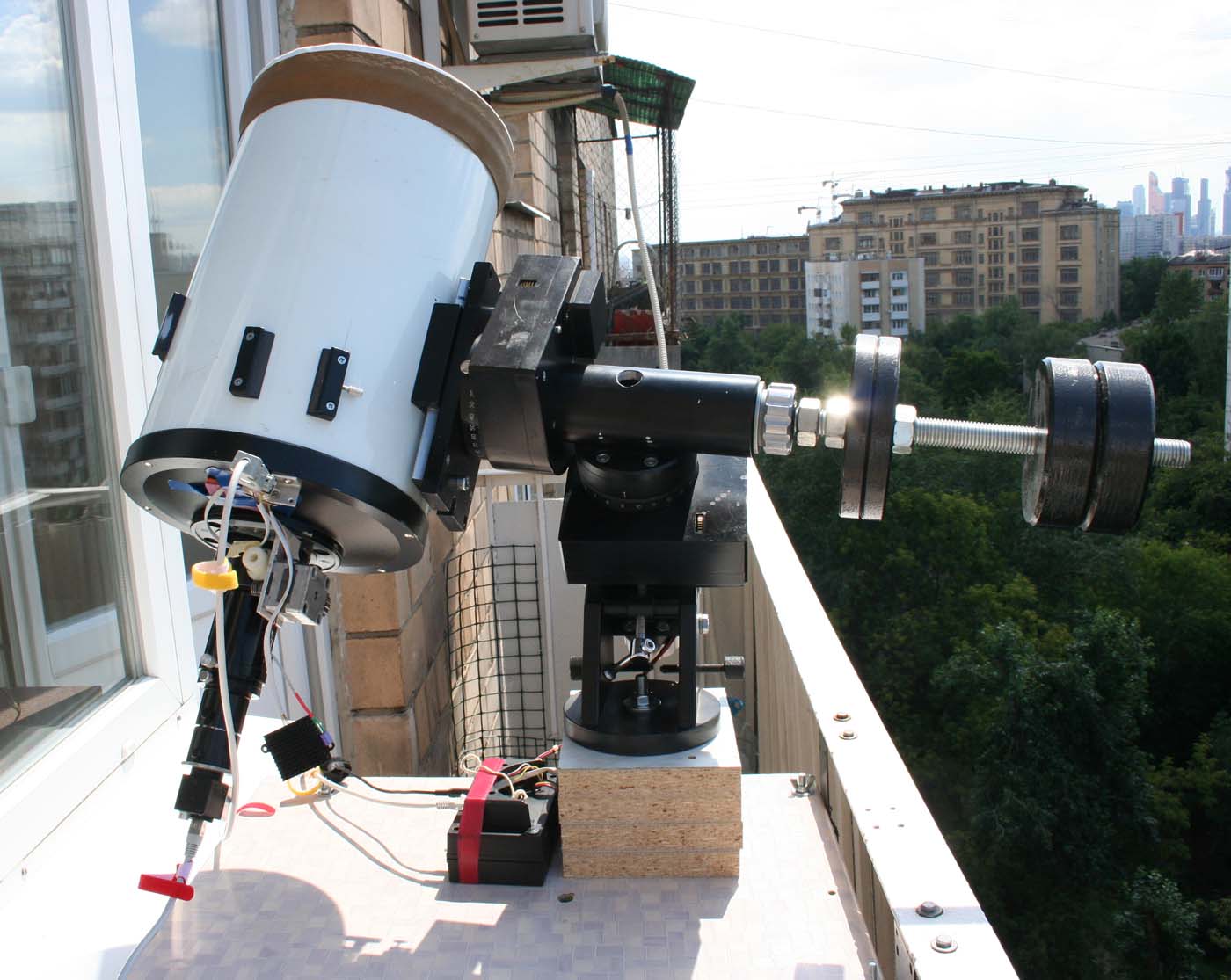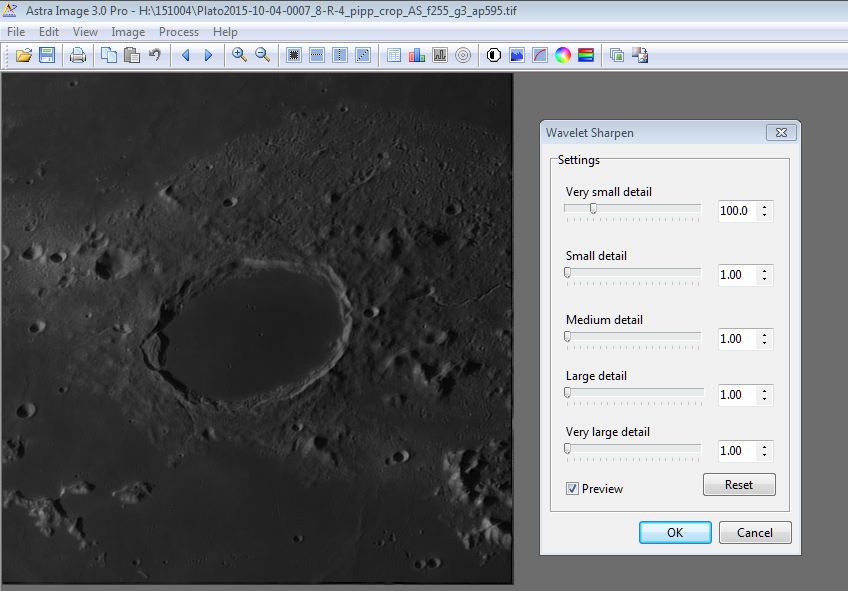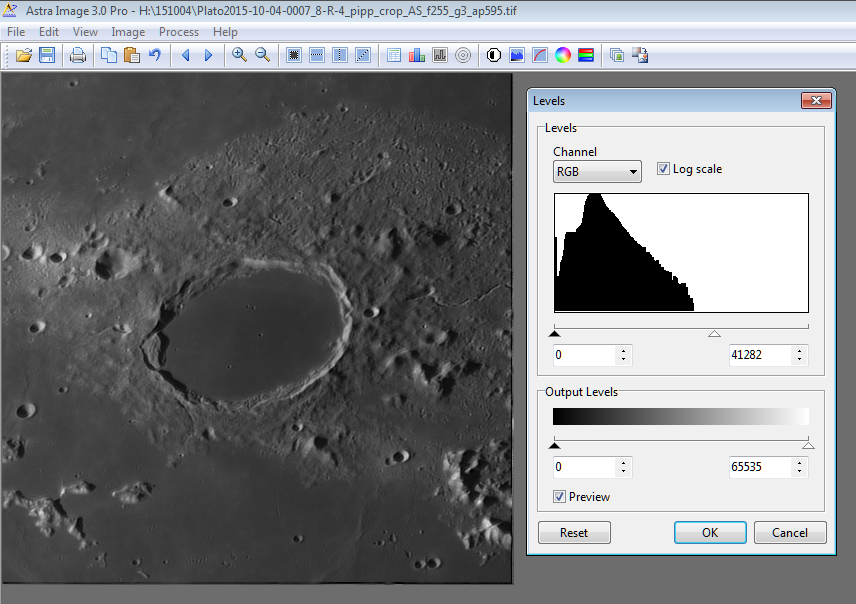
Here are some comments for the Moon panorama image made 4 October. Although I live in a highly populated area of big megapolis, there is still a room for astrophotography. City lights completely wash out faint nebulas and galaxies, but Sun, Moon and planets are easily available for observation and imaging. They are bright and well visible. As one could see, sky glow is not dangerous for Moon imaging. Moreover, low light details are not a target for Moon imaging at all. What we are really hunting for are smallest details of the Moon surface. The second absolutely necessary thing is seeing. In short, this describes how seriously atmosphere distorts the image of the Moon. Any temperature difference of moving air masses act as a weak lens, and many such lenses could blur the image completely. Luckily, in some weather conditions air currents and temperature differences decrease, and one could catch the moments of the stable images. Autumn and spring are best seasons for Moon imaging. Daytime heating of the earth is reasonably low, and Moon is high in the sky. Spring is good for evening Moon, and Autumn is good for Moon in the second half of the night. In addition, morning time is good as the temperature differences decrease, telescope is already cold enough and it's optics is in stable temperature. I use TAL-250K scope, it is catadioptric scope with diameter 250mm and focal length 2130mm. This is my scope at my balkony, ready for daytime Sun imaging: |


Some modifications were made; I installed a motor for the focuser, as it is difficult to get precise focus manually. Imaging computer is at several meters from the scope, and it is difficult to focus manually and see the screen at the same moment. Touching focuser by the hand shakes he scope and it's difficult to catch the exact focus position. Another modification is installation of two thermal sensors: one on the primary mirror and another is located at the small heatsink close to the tube. So I have a possibility to see if optics is close enough to the temperature of the air and don't produce any heated air currents. Focuser and thermal sensors are controlled by special controller, and the same controller is used to control filter wheel. This controller is made by Ivan Ionov, amateur astronomer here in Moscow. Here is a link to this device: http://qhy.narod.ru/FWF/index.htm (in Russian). Camera that I use is a special camera designed specially for Moon, Sun and planets imaging. It has imx174 - modern sensor from Sony (http://www.sony.net/Products/SC-HP/new_pro/december_2013/imx174_e.html ).
|
ZWO ASI174MM camera: http://astronomy-imaging-camera.com/products/usb-3-0/asi174mm/ This camera can capture up to 120 frames per second in full resolution. I use b.w. version, as it is capable to get images in UV and IR light (that color sensors usually can't do with the same performance). My combination of scope, Barlow lens and camera does not cover entire Moon with a single frame. I have to image it part by part. Usually I go across Moon surface from left to right and from top to bottom. It is important to make overlapping images, so it will be possible to create a panorama in specialized software. I don't use any special software to move the scope across Moon surface, so a lot of attention is needed not to miss any piece of the surface. It is very good to align the frame sides parallel to the scope motions from left to right and from up to down - this helps to cover the surface. The size of overlapping areas should be big enough, depending on the software demands. This is how single frame from this video looks like: |

Here is a a link to the crop of the original video, I included best 512 frames. Original video has 1936x1216 pixel size, 3000 frames and is 2.5Gb in size. http://www.makolkin.ru/Files/Plato.avi - 55Mb To process all these videos I used Autostakkert!2 - special software for processing such video files. It is widely used by astrophotographers for Sun, Moon and planets. This software analyze each frame, select the best areas from the best frames, align and stack them. As a result, it saves the so called stack image that could be sharpened by other software. To sharpen images I use Astra Image 3.0, here is a link to this software: http://www.phasespace.com.au/ |

| After image sharpening I can do it's tonal correction. For example: |

| After all videos are processed in the same way with equal settings, I assemble final panorama. There is a lot of different software that do this job. To my experience, I have good results with Image composite editor: http://research.microsoft.com/en-us/um/redmond/projects/ice/ |

More tonal corrections could be applied to final panorama in any image editor. Usually I lighten terminator area, apply unsharp mask with big radius to emphasize tone variations in Moon mare (seas).
Of course, a lot of important things are out of this brief description, so please free to contact with me:
Dmitry Makolkin. |